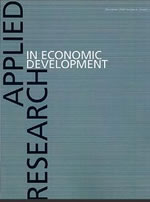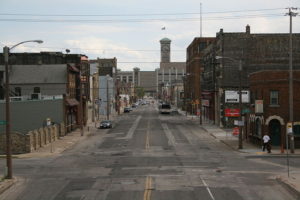Lessons from the Past for Urban Policy in the Era of Trump
By Richard Cowden
Frequent references during the recent campaign to racial tensions and impacted inner-city poverty suggested urban policy would be a hot-button issue for the incoming president. But in truth neither major party candidate offered more than vague outlines and in the weeks following the election cities appear to be falling in the rank order of priorities
Hillary Clinton recited a checklist of budget aspirations for more affordable housing and advocated, mostly in generalities, for infrastructure. But we saw little from her that would qualify as a comprehensive approach to urban problems.
Donald Trump’s pronouncements on the matter also offered practically nothing but some bullet points enveloped in an argument oriented around simplistic views equating “inner city” with “black.” It is far too early to know what a Trump administration has in store for cities. In his campaign statements, Trump spoke to the need for increased federal spending on infrastructure and for incentives to drive more job creation in inner cities.
In a presentation late in the campaign, Trump provided just a few specifics to his promise to revitalize low-income communities. In part, his plan would “propose tax holidays for inner-city investment, and new tax incentives to get foreign companies to relocate in blighted American neighborhoods.” That sounds much like an Enterprise Zone proposal, though it lacks any details on what would qualify as a blighted area or what the city and/or state would need to do, if anything, to be eligible for the incentives.
Trump further advocated an initiative to “empower cities and states to seek a federal disaster designation for blighted communities in order to initiate the rebuilding of vital infrastructure, the demolition of abandoned properties, and the increased presence of law enforcement.” Ostensibly, that could be quite useful if it were a serious proposal, but Trump’s often flippant rhetoric seems more like a campaign throw-away line than a real program. Would it actually mean “blighted” cities would compete for federal disaster relief money with those that had experienced a hurricane? Would the program somehow set aside other funds besides the existing disaster relief funds? Again, what would be the eligibility criteria?
Since Trump used the word “blighted” for both facets of his proposal, one might assume he meant the same areas would be eligible for both sets of benefits. Although some Trump surrogates used the term “Enterprise Zones” when talking about his urban initiatives, he has not couched his proposals in those terms, nor has anyone in the Republican leadership.[1] If Trump intends to do anything at all with these fragmentary ideas, it seems inevitable that he or someone carrying his water in Congress eventually would wrap them up in a legislative package that’s called Enterprise Zones, or something like it. At some level, that might not even be a bad idea if they set the stage for the same kind of Enterprise Zone policies the states established in the ‘80s and ‘90s as they anticipated federal action on legislation of the same name.
Much has been written about the Enterprise Zones chapter in urban legislation, most of it in the context of support or criticism of tax incentives. But what cannot be dismissed is that over 20 years, it held center stage in the discussion of urban policy. It is as close as we have come to having a means of conveying signals among all levels of government about what areas are in the greatest need for assistance and how complementary solutions could be implemented. That is no small thing, even if the body politic eventually tired of bickering over it.
Ronald Reagan called for Enterprise Zone legislation in his first State of the Union Address in 1982 and similar appeals were included in most States of the Union by Reagan and George H.W. Bush. Bill Clinton implemented Empowerment Zones and advocated zone-based policies in all but one of his State of the Union messages through 2000. Enterprise Zones did not appear in George W. Bush’s 2001 address and have not been mentioned as a legislative priority since.
Even after Empowerment Zones faded into the background as their designation terms expired, President Barack Obama quietly designated 22 Promise Zones, a characteristically understated initiative that challenges cities themselves to address areas of decline and offers solid reinforcement without promising too much. Promise Zones should be familiar to the many cities that established Enterprise Zones under state authority in the `80s and `90s. Many involved tax incentives, which the Reagan and Bush administrations pushed, but a lot of cities simply used them to add focus to their ongoing redevelopment plans.
By 1997, the states’ EZs had recorded about 450,000 new jobs and $55 billion in new private investment. Not bad for a program that cost the federal government exactly nothing. They also proved that federal policymakers could induce a fairly high level of revitalization activity at the city/state level merely by setting out eligibility standards needed to compete for a federal designation. Further, they illustrated that whatever the federal government may offer, much of the actual street-level work can and should be done by the cities and states.
Evolving Urban Policies
One could make the case that urbanization itself, a phenomenon that occurred about the same time America took shape, has been the most profound human and technological development in our country’s history. The pace and scale of urbanization that drove the U.S. economy in the 20th century also spun off several disturbing, unprecedented side effects—sprawl, congestion, fragmentary jurisdictional problems, segregation.
As urban environments presented more and more confounding challenges, cities gained a place in Washington’s political dialogue. Demands for better living conditions forced political leaders to articulate responses. Until about 2000, when urban policy strangely moved to the back burner, America adopted, debated, rejected, reinvented several urban policies. In the `30 and `40s we bulldozed shabby neighborhoods under the rubric of slum clearance. In the `50s it was urban renewal.
The conflagrations and violence that raged during the `60s greatly increased the urgency to address urban problems at the federal level. The result was the Great Society, which might be regarded as the first time Washington sought to deal with the multiplicity of issues with not just one or two programs, but with a complex of actions involving some measure of state and local coordination. Jimmy Carter had little opportunity to revamp the clumsy Johnson era policy.
In 1980, close to the end of Carter’s term, the Liberty City/Overtown areas of Miami erupted in flames, conjuring memories of the `60s riots. The only Republican to acknowledge the crisis was Rep. Jack Kemp, who borrowed from British Prime Minister Margaret Thatcher’s newly minted Enterprise Zone initiative and crafted it as a supply-side riposte to the Great Society.
Kemp posited that the Democrats’ ideas actually exacerbated the problems because they were based on massive federal spending, which was anathema to the Republican world view. The Great Society fostered dependency, Kemp argued, and was implemented through inefficient federal bureaucracy. That logic suggested the opposite of public spending could hold the answer. That would not mean a laissez-faire approach; Enterprise Zones would still seek to engineer economic growth in distressed areas. But they would do so through the two forms of activism that Republicans find palatable: tax incentives and deregulation.
Gridlock
It is worth reviewing what occurred in this field shortly after Reagan declared his Revolution and turned policies in every corner of the federal government over to the likes of Kemp and other incoming conservative activists. Congressional Democrats resented Kemp, particularly after he rammed through the 1981 Kemp-Roth tax cuts. That contempt was most acute among those in a position to advance his urban legislation, such as Rep. Charles Rangel of Harlem and Rep. Dan Rostenkowski, the powerful chairman of the House Ways and Means Committee from Chicago. Anyone seeking an early example of congressional gridlock need look no further than the Enterprise Zone bill. Kemp would countenance no funding in his proposal and Democrats had no use for supplysiders.
At that time, I was executive director of the American Association of Enterprise Zones (AAEZ), a non-profit representing cities and states that established zones under state authority. Most of the association’s members were Democratic-run cities that would qualify for EZ status under Kemp’s legislation. Local officials doubted the value of federal tax incentives but reasoned that was all they could expect from Washington for the time being.
Enterprise Zones were interesting because they had become some 800 facts on the ground in 38 states—true laboratories of democracy—even as Congress dithered. AAEZ advised local and state officials not to rely solely on tax incentives in the EZs but to promote innovative redevelopment ideas and create jobs using any tools they thought appropriate.
That became especially relevant after Kemp himself dropped the perfect Catch 22 on his own EZ proposal when he helped negotiate the 1986 Tax Reform Act. Kemp insiders noted later that Enterprise Zones could have been worked into the overall tax package. They would have been a pittance in relation to the huge sums for tax cuts and loophole closures that Kemp and Rostenkowski shoved back and forth like poker chips across the bargaining table. The Low-Income Housing Tax Credit (LIHTC), for example, was a new tax expenditure that managed to find its way into the Tax Code during the negotiations, but Enterprise Zones, a much smaller-scale proposal, somehow never made it onto the table even though it was supposedly Kemp’s signature issue.
After the Tax Reform Act passed, the flat tax suddenly was in and targeted federal tax breaks, which Kemp continued to insist were the only EZ benefits he would countenance, were out. In doing so, he assured that the hundreds of cities lining up for the chance to apply for a prospective federal EZ designation would continue to wait.
As a consequence, federal urban policy hovered in an induced coma throughout the rest of Ronald Reagan’s and George H.W. Bush’s years, right up until the South Central Los Angeles riots in the spring of 1992, which arguably spelled Bush’s downfall.
After ignoring EZs for six years, Kemp, by then Bush’s secretary of housing and urban development, revived them as the administration’s answer to urban violence, which appeared likely to spread. Lawmakers pushed through a compromise emergency urban aid package that summer, with both tax incentives and direct funding oriented around the EZ theme. It was the first time the Democratic leadership conceded to accommodate the supply siders with a bill including tax incentives. But because it also proposed some spending provisions, Kemp and Bush disdained it. Although Congress sent it to Bush well before the November election, he put off signing it (such was the GOP aversion to new urban spending), then vetoed it on his way out.
The Clinton Transition
Shortly after the 1992 election a Clinton transition team member dialed up AAEZ out of the blue, acknowledging somewhat sheepishly that Clinton did not know much about the policy, even though he’d signed Enterprise Zone legislation in Arkansas and had included it as one of his campaign promises. She listened attentively to what must have been an unexpected description of EZs as the states had interpreted them. They could become what amounted to a turnkey framework for a federal EZ-styled urban policy and all it needed was political leadership. Targeting, not tax incentives, was the essence of the concept. Liberated from Kemp’s doctrinaire approach, lawmakers could offer any mix of benefits that could win a majority.
The staffer handed the ball to Paul Diamond, a senior transition team official, who liked that line of thinking. He asked for a concise set of recommendations and in a matter of days, AAEZ had become a player in a major new federal urban policy. Or so it seemed.
An EZ’s key innovation was a proposed two-tiered approach to EZs. It would offer a baseline of support by prioritizing and fast-tracking existing federal resources for localities that committed to zone-specific redevelopment. That could be offered to most existing state-designated zones with a minimum of bureaucracy and on a budget-neutral basis. Once qualified as a tier one zone, the local government, in league with its state and local private stakeholders, could compete for higher levels of federal assistance.
The association was a player, as it turned out, but the game was “telephone.” The administration incorporated the two-tiered idea into its “Empowerment Zone” legislation but turned it upside down and treated the states’ EZs as if they’d never happened. Under Clinton’s policy, enacted in 1993, six cities would win a designation and a windfall of $100 million each in direct funding, plus tax incentives mostly keyed to hiring Empowerment Zone residents. A lower tier of 50 also-ran competitors had to work just as hard to develop their strategies and applications as the lucky six cities, but would get little more as “Enterprise Communities” than a $3 million block grant and some minor tax benefits.
Clinton turned EZs/ECs over to the young Andrew Cuomo, then an assistant secretary at the Department of Housing and Urban Development, who was rumored to have cut deals with Rostenkowski and Rangel to wire zone designations for Chicago and New York. Not since the days of Lyndon Johnson had anything like $100 million block grants been available to local governments and the mayors crawled over each other to get them.
When the administration announced the first round of designations in 1994, sure enough Chicago and New York won their prizes, along with Philadelphia-Camden, Baltimore, Detroit, and Atlanta. The hue and cry from the unsuccessful applicants was so fierce, the administration had to add Los Angeles and Cleveland to the mix. Congress approved another 15 Empowerment Zone designations in 1999 and eight in 2001, plus 49 more Enterprise Communities. Yet even the Clinton administration seemed disenchanted with its own policy.
A Lost Opportunity
Perhaps they didn’t understand that if they dangled $100 million grants that only a few cities could have, they would engender discontent but they should have. It was why AAEZ recommended a gradual opening up of such a policy, with larger awards available only to those communities that demonstrated a sustained state/local/private commitment. Soon after the EZ policy’s awkward early designation rounds, Clinton focused on Welfare Reform and on his re-election. Much of Clinton’s second term fell victim to his sex scandal and subsequent impeachment trial.
The Clinton administration saw EZs as a ticket it had already punched. It moved on to programs, such as New Markets Tax Credits, that were not much more than a demonstration for a handful of cities. New Markets did show that in some cases companies could be drawn into a low-income neighborhood if offered a whopping 39 percent federal investment tax credit. But the program dealt with just a few businesses in the 100 or so communities that had access to it. New Markets required no commitments or strategic planning from participating cities and no city-state coordination, but were less messy to implement than EZs.
New Markets produced good, neat press releases, while EZs were said to be ineffective if they didn’t transform the entire designated area. They made it easier for Washington to point to private-sector outcomes resulting from a specific public-sector input, but they were not designed to address a wider set of issues that hampered redevelopment, and many companies that received the credits did not remain in place for the long run.
Over time, Enterprise Zone-styled policies could be seen in the larger context of state and federal responsibilities to the cities themselves. Poverty festered in inner cities largely because industries that once supported the community’s economic base closed down and new businesses started up far away in the suburbs, which often excluded housing for low-income and largely immobile families. Manufacturing properties that once employed people in adjacent neighborhoods became obsolete, draining the city of its tax base and jobs. As those dire impacts spiraled in patterns that were recognizable and consistent in countless urban centers, municipal leaders knew they had little hope of reversing the trends without outside assistance.
In many ways it is the same syndrome that we see prominently this year in the small Rust-Belt cities that lost crucial industries to automation or offshoring. Those towns lost their economic moorings to factors well beyond their control and are looking to Washington for help.
Facing Reality in Redevelopment
Economic development practitioners understand all of these dynamics and more. Sometimes a vacant business facility can be readily re-used by a willing enterprise responding to one incentive or another. But in many inner cities the closing factories—often entire complexes of factories—left behind dilapidated, toxic, and vandalized structures that must be removed before any new investment could arrive.
Local EZ administrators often complained that what they really needed was funding to reconfigure streets and utilities, demolish abandoned facilities, and decontaminate outdated properties. They scoffed at the notion that a benevolent private-sector entity would somehow do all that and then start up a new venture in a still-risky neighborhood on the strength of a tax break.
To be sure EZ-eligible areas often need even more than infrastructure funding. One might make the case for any number of programs to address the human needs of those left behind by evolving urban economies, and many of them have merit. But decision-makers too often have confused programs for people in urban areas with urban policy itself.
In the best cases, cooperative multi-jurisdictional planning and public-private coordination have been able to turn around seemingly hopeless urban areas by applying a well-conceived mix of solutions. And investment in rehabilitating those critical abandoned areas can have an outsized impact on the inner-city poor and at the same time reclaim the value of key, centrally located sites. It is a form of “smart growth.”
The nice thing about infrastructure is that it can be funded and installed once and yield ongoing benefits. Unlike human services that must secure appropriations each year through changing political tides, it is not as subject to the whims of Congress.
The London Docklands Example
A revealing 1983 conversation with a manager at the London Docklands, which was the first Enterprise Zone Britain designated in 1981, offered valuable insight into successful redevelopment planning. Note that in addition to offering tax incentives, the British committed funding to the Docklands to clear out old infrastructure built early in the industrial age and to completely reconfigure systems needed for new development.
He explained that the $40 million or so that had been invested in rehabilitating the area skewed the early analyses of the per-job costs in the zone to the pricey side. But the point, he said, was the same infrastructure would also support the many jobs to be created in the future. History proved him right. The Docklands over the past 35 years has been critical to London’s vibrant economy. Could it have been done without tax incentives? Who knows? Could it have been done without the new infrastructure? Not a chance.
Would such investment in infrastructure be all we need to address problems of poverty, racial tension, underperforming schools? Hell no. But once the policymaking process does nail down that commitment, it can become a significant attraction to investors looking for a location with up-to-date infrastructure.
A Test for Trump
Developing real estate is one of the few areas in which Donald Trump has experience with public policy and public administration, and not all of those dealings have been positive. Until he takes office no one knows if his campaign statements are any more than just that. But unlike Ronald Reagan, who entered the presidency with similar conservative fervor, Trump will have majorities in both the House and Senate. One could envision an overwhelmingly Republican Congress packaging a tax incentive and targeted infrastructure program into a new version of Enterprise Zones.[2]
What? Go back to square one with Enterprise Zones? It may sound far-fetched, but in the time it would take Congress to enact the legislation, write the rules, and open the process for applications, the cities and states could easily re-establish policies resembling state-designated zones. In some cases, the zones still exist. They need to do nothing more than they did 30 years ago—coordinate and perhaps sharpen their redevelopment strategies around a set of criteria spelled out in federal legislation and then seek a federal designation. That is neither a Democratic nor Republican notion. It is just a way to line up planning activity at all three levels of government.
Policymakers would be well advised not to simply draw lines around areas that fit a given set of distress criteria and offer hugely generous tax benefits to any company that locates there. The state-designated zones that took this passive approach showed it to be ineffective, and even Kemp wasn’t disposed to do that. Any such policy inevitably would have to be offered in a limited number of problem-plagued localities, and that would mean holding a competition for designations. As indicated earlier, a premium should be placed on demonstrating an integrated, public-private commitment, with state sponsorship and support.
Further, separate kinds of designations should be available to hard-core urban industrial areas and to rural areas. Both may exhibit the same levels of unemployment and low household income. But smaller cities—the very kinds that have suffered from recent plant closures—often have plenty of inexpensive sites available that do not need intensive rehabilitation. That might suggest using the same kinds of incentives in urban and rural areas, but devising a more thoroughgoing infrastructure program in inner-city zones.
Given the low probability that cities will see any other new federal support in the foreseeable future, this might be the best way to proceed with urban policy during the upcoming Trump years. Republicans have long claimed they favored tax incentives for investment in inner cities, but were thwarted by Democratic opposition. Now might be a good time to find out if Trump will back up his brassy rhetoric about offering something new for urban populations. If he and Republicans in Congress demonstrate they are serious about enacting such a policy, they just might find an opportunity for bipartisanship.
Richard Cowden is a journalist and urban planner who served as executive director of the American Association of Enterprise Zones from 1985 to 1999. He retired in 2015 as a managing editor who covered financial services and commercial real estate law at Bloomberg BNA.
FOOTNOTES
[1] Speaker of the House Paul Ryan (R-Wis.) introduced an “anti-poverty plan” in early June that speaks to problems often associated with low-income communities (substandard education, underemployment). Missing from his agenda is any reference to the centerpiece of his old boss and mentor Jack Kemp’s perennial urban poverty action plans: Enterprise Zones, which were once a de rigueur component of the GOP policy agenda. But Ryan appears to have left them out of the mix. The ideas he enunciated incorporate many Republican principles, such as reducing the number of poverty-related programs, consolidating funds in block grants to states, imposing new work requirements, eliminating past abuses.
[2] Washington Post business columnist Steven Pearlstein has already outlined an ingenious scenario: “The president appoints as Secretary of Commerce a seasoned financial and corporate dealmaker and orders him to begin negotiations with American corporations to bring back manufacturing jobs, or create new ones, in designated `empowerment zones’ — regions suffering from high unemployment, declining population and property values, low levels of educational achievement and high levels of drug use and other social dysfunction. For every net new job created, there would be a $15,000 annual tax credit in each of the next five years. But that credit could only be applied against taxes owed for foreign profits repatriated to the United States at the lower 15 percent tax level originally proposed by Trump and pushed through the new Congress with strong Democratic support. Only companies that sign such deals would be eligible for the reduced 15 percent tax rate on past profits. Companies that do not sign deals would still qualify for the 15 percent rate, but only for future profits.” Pearlstein goes on to posit that if the program attracted $1 trillion back to the U.S., it would yield $150 billion in tax revenue; about half of that would go to the eligible businesses as tax credits and the other $75 billion could fund an infrastructure bank.







Comments
No comments yet. You should be kind and add one!
The comments are closed.